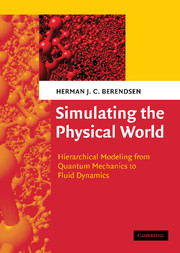Book contents
- Frontmatter
- Contents
- Preface
- Symbols, units and constants
- Part I A Modeling Hierarchy for Simulations
- Part II Physical and Theoretical Concepts
- 12 Fourier transforms
- 13 Electromagnetism
- 14 Vectors, operators and vector spaces
- 15 Lagrangian and Hamiltonian mechanics
- 16 Review of thermodynamics
- 17 Review of statistical mechanics
- 18 Linear response theory
- 19 Splines for everything
- References
- Index
15 - Lagrangian and Hamiltonian mechanics
Published online by Cambridge University Press: 05 June 2012
- Frontmatter
- Contents
- Preface
- Symbols, units and constants
- Part I A Modeling Hierarchy for Simulations
- Part II Physical and Theoretical Concepts
- 12 Fourier transforms
- 13 Electromagnetism
- 14 Vectors, operators and vector spaces
- 15 Lagrangian and Hamiltonian mechanics
- 16 Review of thermodynamics
- 17 Review of statistical mechanics
- 18 Linear response theory
- 19 Splines for everything
- References
- Index
Summary
Introduction
Classical mechanics is not only an approximation of quantum mechanics, valid for heavy particles, but historically it also forms the basis on which quantum-mechanical notions are formed. We also need to be able to describe mechanics in generalized coordinates if we wish to treat constraints or introduce other ways to reduce the number of degrees of freedom. The basis for this is Lagrangian mechanics, from which the Hamiltonian description is derived. The latter is not only used in the Schrödinger equation, but forms also the framework in which (classical) statistical mechanics is developed. A background in Lagrangian and Hamiltonian mechanics is therefore required for many subjects treated in this book.
After the derivation of Lagrangian and Hamiltonian dynamics, we shall consider how constraints can be built in. The common type of constraint is a holonomic constraint that depends only on coordinates, such as a bond length constraint, or constraints between particles that make them behave as one rigid body. An example of a non-holonomic constraint is the total kinetic energy (to be kept at a constant value or at a prescribed time-dependent value).
We shall only give a concise review; for details the reader is referred to text books on classical mechanics, in particular to Landau and Lifschitz (1982) and to Goldstein et al. (2002).
There are several ways to introduce the principles of mechanics, leading to Newton's laws that express the equations of motion of a mechanical system.
- Type
- Chapter
- Information
- Simulating the Physical WorldHierarchical Modeling from Quantum Mechanics to Fluid Dynamics, pp. 397 - 422Publisher: Cambridge University PressPrint publication year: 2007



